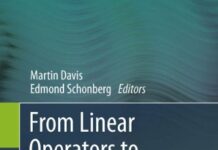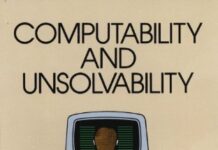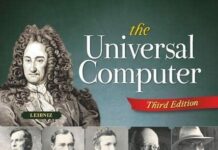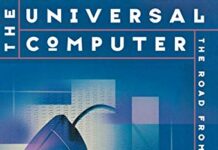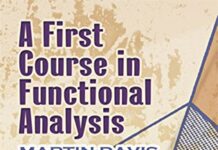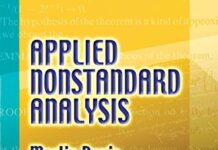
Ebook Info
- Published: 1994
- Number of pages: 609 pages
- Format: PDF
- File Size: 9.89 MB
- Authors: Martin Davis
Description
Computability, Complexity, and Languages is an introductory text that covers the key areas of computer science, including recursive function theory, formal languages, and automata. It assumes a minimal background in formal mathematics. The book is divided into five parts: Computability, Grammars and Automata, Logic, Complexity, and Unsolvability.Computability theory is introduced in a manner that makes maximum use of previous programming experience, including a “universal” program that takes up less than a page.The number of exercises included has more than tripled.Automata theory, computational logic, and complexity theory are presented in a flexible manner, and can be covered in a variety of different arrangements.
User’s Reviews
Reviews from Amazon users which were colected at the time this book was published on the website:
⭐This is the standard-work on theory taught at the undergraduate- and graduate-level. It requires ample sophistication in discrete mathematics and proof-work. It would be tackled after the sophomore-year for an honor-roll student in computing
⭐This is one of the best written books I have seen, and I have seen a few as a long-time working professional. No wonder it it selling well after 20 years. Very complex topics made very approachable without sacrificing depth or breadth. For sure I will look forward to other titles from Martin Davis.
⭐The authors of this book define theoretical computer science as the mathematical study of models of computation, and they do an excellent job of detailing the major results in the theory of computation as related to mathematical logic. Mathematicians, programmers, and philosophers will find the book an effective one in which to learn computability theory, and it serves well as a textbook for courses in the subject. After a brief review of elementary mathematics and mathematical logic in chapter 1, the authors move right into the consideration of computable functions in chapter 2. They choose a particular abstract programming language in which to study the computability theory, which is built from variables, and programs that can be built from lists of instructions. Examples of programs are given, which have a Fortran flavor, with examples of computing partial functions. Unfortunately, a plethora of GOTO statements appear in the programs, and throughout the rest of the book, which is surprising given the publishing date. The use of these GOTO statements in the book is a major annoyance. Then in chapter 3, the authors discuss primitive recursive functions, beginning with a treatment of composition, followed by the all-important concept of recursion. The class (PRC) of primitive recursive functions is introduced, and shown to be computable. The primitive recursive predicates are introduced, followed by a proof that the existential and universal quantifiers over an element of a PRC class are also PRC. This is followed by a discussion of minimalization and Godel numbers. The next chapter is very interesting, wherein the famous halting problem is discussed and related to Church’s thesis. The authors stress, most importantly, that an algorithm cannot be defined outside of the choice of a language, and therefore Church’s thesis cannot be proved as a theorem. The authors also introduce recursively enumerable sets and show, via diagonalization, that non-recursively enumerable sets exist. They give an interesting example of a function that is computable but not primitive recursive. The next chapter extends the results to strings of symbols instead of just numbers, and the authors introduce programming languages for doing string computations. One of these is the famous Post-Turing language, which they use to discuss the halting problem, with a variant used in the next chapter on Turing machines. The authors discuss the famous halting problem for Turing machines in this chapter. This is followed in chapter 7 by a discussion of productions and simulation of nondeterministic Turing machines. A very lucid treatment of Post’s correspondence problem is given. Things get somewhat more complicated in chapter 8, where the authors attempt to classify unsolvable problems. It contains one of the best discussions I have seen in the literature on oracles, and the authors give a very clear treatment of arithmetic hierarchies. The second part of the book reads more like a book on compilers, as the authors delve into the area of grammars and automata. Regular languages, deterministic and non-deterministic finite automata are discussed, and Kleene’s theorem, which states that regular languages and finite automata define the same languages, is proven. The context-free languages, so familiar from the study of compilers, are discussed also, along with a proof that a context-free grammar can be reduced to a Chomsky normal form grammar. Pushdown automata, needed for accepting context-free languages, are treated in detail. The authors give a good explanation here as to the additional facilities needed for a finite automaton to decide if a word belongs to a “bracket” language. Chomsky hierarchies are also discussed, and the authors motivate nicely the need for a linear bounded automaton to accept context sensitive languages. Part three of the book is an overview of mathematical logic, and begins with a treatment of the propositional calculus. The satisfiability problem is discussed for this system, along with how to reduce formulas to normal form. The important compactness theorem is given a very detailed proof. Predicate calculus is then discussed, and Herbrand’s theorem, which effectively reduces logical inference in predicate calculus to a problem of satisfiability of universal sentences, is proven. This theorem is fascinating and has important applications to automated theorem proving, as it ties together semantic and syntactical properties of a formal system. The Godel incompleteness theorem and the unsolvability of the satisfiability problem in predicate logic is proven. In part 4, issues in computational complexity are addressed, the measure of complexity given in terms of the Blum axioms. This is a very abstract way of introducing complexity theory, as it introduces measures of complexity that more general than time and space complexity. The fascinating gap theorem, comparing program performance on two computing machines via complexity measures, is proven. This is followed by a detailed discussion of the speedup theorem, which essentially states that there is a wildly complicated recursive function such that for any program computing this function, there exists another program computing the function that works a lot faster for almost every input. The polynomial-time computability is discussed along with the famous P vs NP problem, with the discussion given in terms of Turing machines. Examples of NP-complete problems are given. The last part of the book covers semantics, with operational and denotational semantics defined and compared. The emphasis in this part is on programming languages and constructions that one would actually find in practice, and so the preceding chapters on computable functions must be extended. The concept of an approximate ordering is introduced to allow for the instantaneous of a computation at some point before its completion. The denotational semantics of recursion equations and infinitary data structures are discussed, with the latter put it in to deal with the sophisticated systems that are constructed here. The discussion here is very involved, but the authors do a fair job of explaining the need for these types of data structures. The same is done for operational semantics, and the authors finally show that the computable numerical functions are actually partially computable. They then show the existence of computable irrational numbers.
⭐I only have to say that this might be the best book out there for theory of computer science and related Math models.
⭐This is not a common book on Computability and Complexity as Hopcroft-Ullman, Sipser or Papadimitrou. You won’t find here too many words describing topics: you’ll find the power and elegance of a superlative mathematical approach from one the best authors of the century in the field. Conversely, you’ll find here a detailed and elegant treatment of the whole history of computational models that starts at the Primitive Recursive Functions, something you won’t find in the other books above mentioned.A special note goes to the chapter on Blum’s complexity, which is about the only good place where I found it and from where I studied for my course on Complexity I.For this reason the book requires quite more attention than others, but it really worths all the time one can spend reading it. Truly understanding Computability and Complexity as Professor Davis teaches them with this book is in my opinion a definitely high achievement, bringing the sensation that you grasp it totally, with no space for ambiguity or weakness.
⭐I first learned computability from this book. He may sometimes set things up in such that way that makes you wonder what the point is, but then you later see why and it ends up being very efficient and clear. I think the chapters on logic are the most painless way to learn that subject.
⭐I haven’t found a better book on the Theoretical foundations of Computer Science. However since this IS theory the text can be a bit cryptic. Still, I’d recomend this book to any PhD Candidate or full Professor. Even a lowly Master’s student like myself could use it.
⭐This book contains all the foundational information that you may need to understand theoretical computer science. The book not only presents but also proves the most relevant form of computations. Using those forms of computations, the authors prove several relevant theorems in computer science (e.g. Rice theorem, impossibility of the halting problem, Godel incompleteness theorem for predicate calculus, Cook’s theorem, etc). All the theorems are well motivated and presented during the right time.I’d recommend this book to anyone interested int he theory of computability. Indeed, the book covers so many topics that you’d probably need 3 or 4 books to get the same material.
⭐Contiene los temas necesarios para estudiar teoría de la computación y complejidad, en el formato de pasta dura es muy duradero.
⭐
Keywords
Free Download Computability, Complexity, and Languages: Fundamentals of Theoretical Computer Science (Computer Science and Scientific Computing) 2nd Edition in PDF format
Computability, Complexity, and Languages: Fundamentals of Theoretical Computer Science (Computer Science and Scientific Computing) 2nd Edition PDF Free Download
Download Computability, Complexity, and Languages: Fundamentals of Theoretical Computer Science (Computer Science and Scientific Computing) 2nd Edition 1994 PDF Free
Computability, Complexity, and Languages: Fundamentals of Theoretical Computer Science (Computer Science and Scientific Computing) 2nd Edition 1994 PDF Free Download
Download Computability, Complexity, and Languages: Fundamentals of Theoretical Computer Science (Computer Science and Scientific Computing) 2nd Edition PDF
Free Download Ebook Computability, Complexity, and Languages: Fundamentals of Theoretical Computer Science (Computer Science and Scientific Computing) 2nd Edition
